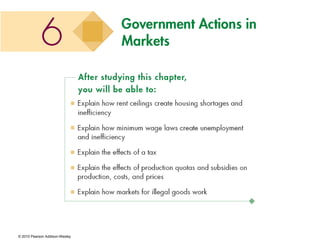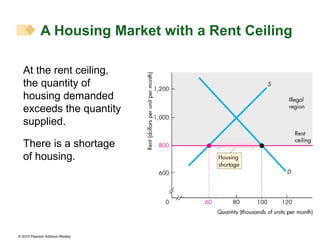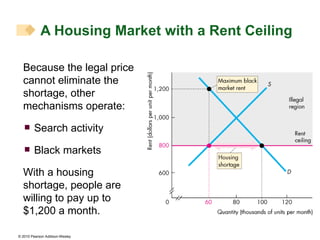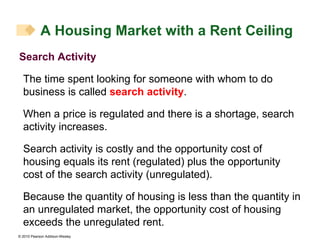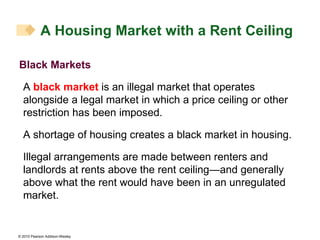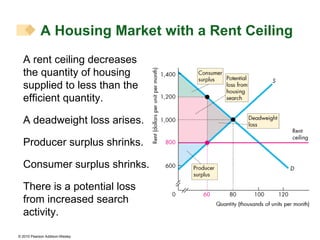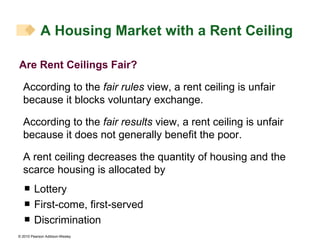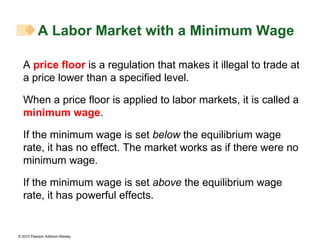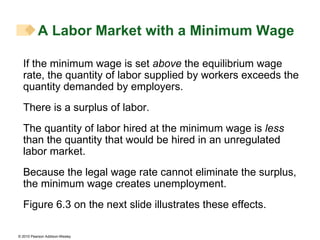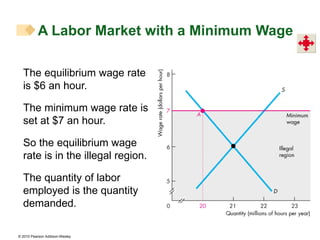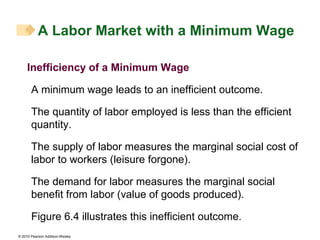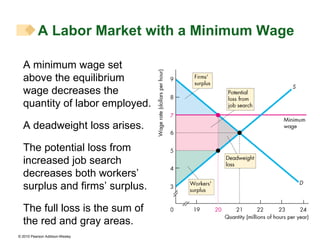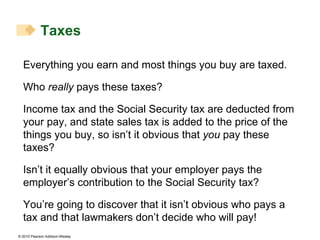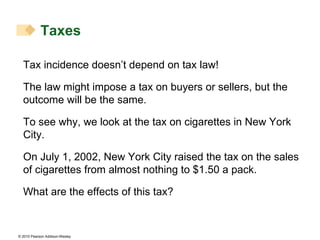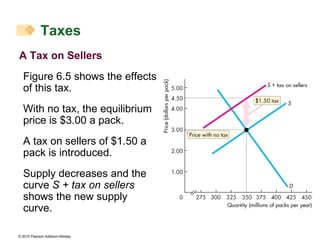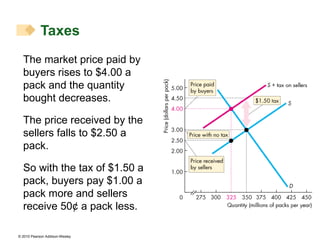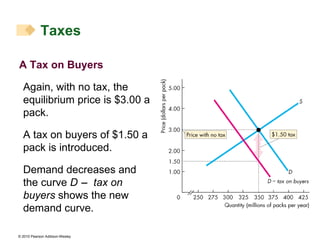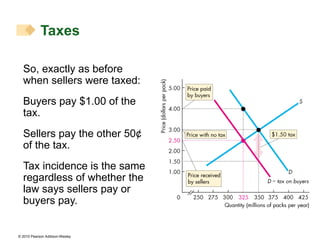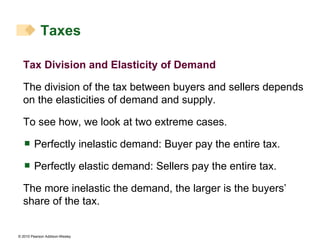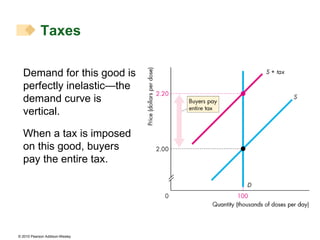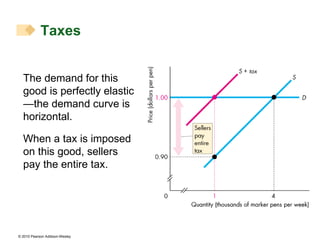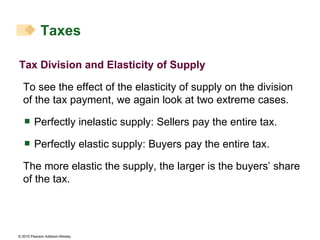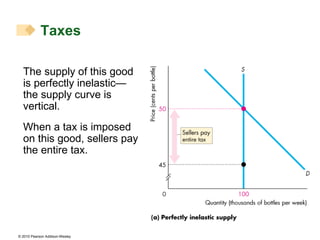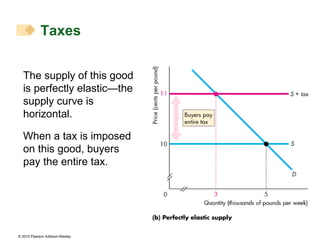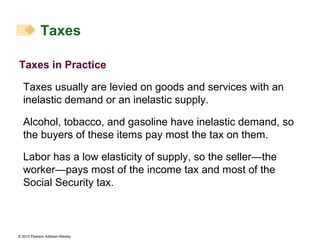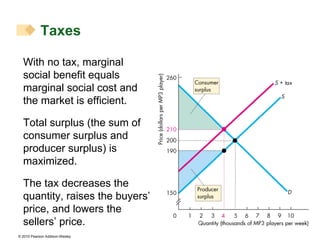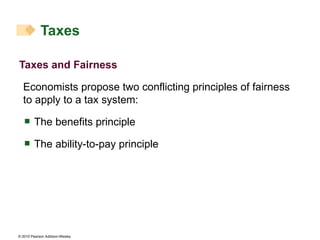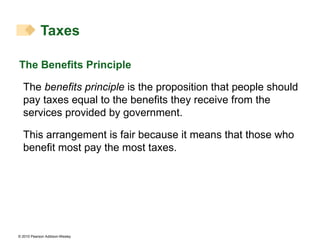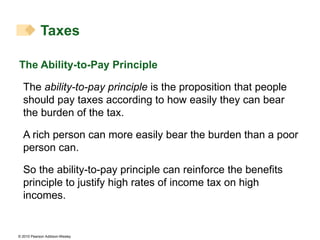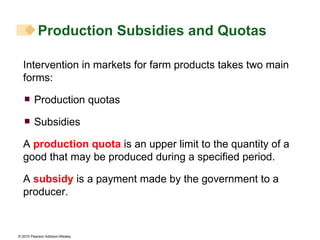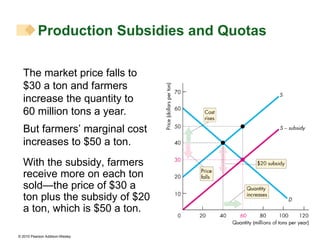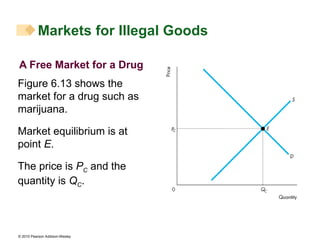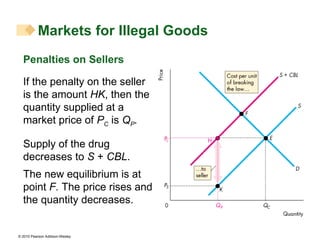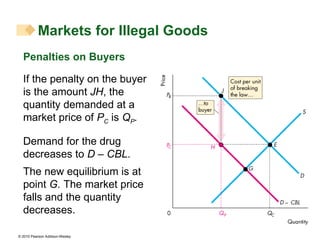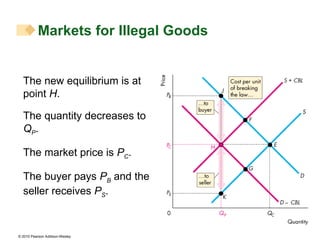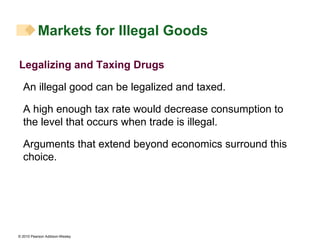Ch06
- 1. ╠²
- 2. ╠²
- 3. A price ceiling or price cap is a regulation that makes it illegal to charge a price higher than a specified level. When a price ceiling is applied to a housing market it is called a rent ceiling . If the rent ceiling is set above the equilibrium rent, it has no effect. The market works as if there were no ceiling. But if the rent ceiling is set below the equilibrium rent, it has powerful effects. A Housing Market with a Rent Ceiling
- 4. Housing Shortage Figure 6.1 shows the effects of a rent ceiling that is set below the equilibrium rent. The equilibrium rent is $1,000 a month. A rent ceiling is set at $800 a month. So the equilibrium rent is in the illegal region. A Housing Market with a Rent Ceiling
- 5. At the rent ceiling, the quantity of housing demanded exceeds the quantity supplied. There is a shortage of housing. A Housing Market with a Rent Ceiling
- 6. Because the legal price cannot eliminate the shortage, other mechanisms operate: Search activity Black markets With a housing shortage, people are willing to pay up to $1,200 a month. A Housing Market with a Rent Ceiling
- 7. Search Activity The time spent looking for someone with whom to do business is called search activity . When a price is regulated and there is a shortage, search activity increases. Search activity is costly and the opportunity cost of housing equals its rent (regulated) plus the opportunity cost of the search activity (unregulated). Because the quantity of housing is less than the quantity in an unregulated market, the opportunity cost of housing exceeds the unregulated rent. A Housing Market with a Rent Ceiling
- 8. Black Markets A black market is an illegal market that operates alongside a legal market in which a price ceiling or other restriction has been imposed. A shortage of housing creates a black market in housing. Illegal arrangements are made between renters and landlords at rents above the rent ceilingŌĆöand generally above what the rent would have been in an unregulated market. A Housing Market with a Rent Ceiling
- 9. Inefficiency of Rent Ceilings A rent ceiling set below the equilibrium rent leads to an inefficient underproduction of housing services. The marginal social benefit from housing services exceeds its marginal social cost and a deadweight loss arises. Figure 6.2 illustrates this inefficiency. A Housing Market with a Rent Ceiling
- 10. A rent ceiling decreases the quantity of housing supplied to less than the efficient quantity. A deadweight loss arises. Producer surplus shrinks. Consumer surplus shrinks. There is a potential loss from increased search activity. A Housing Market with a Rent Ceiling
- 11. Are Rent Ceilings Fair? According to the fair rules view, a rent ceiling is unfair because it blocks voluntary exchange. According to the fair results view, a rent ceiling is unfair because it does not generally benefit the poor. A rent ceiling decreases the quantity of housing and the scarce housing is allocated by Lottery First-come, first-served Discrimination A Housing Market with a Rent Ceiling
- 12. A lottery gives scarce housing to the lucky. A first-come, first served gives scarce housing to those who have the greatest foresight and get their names on the list first. Discrimination gives scarce housing to friends, family members, or those of the selected race or sex. None of these methods leads to a fair outcome. A Housing Market with a Rent Ceiling
- 13. A price floor is a regulation that makes it illegal to trade at a price lower than a specified level. When a price floor is applied to labor markets, it is called a minimum wage . If the minimum wage is set below the equilibrium wage rate, it has no effect. The market works as if there were no minimum wage. If the minimum wage is set above the equilibrium wage rate, it has powerful effects. A Labor Market with a Minimum Wage
- 14. If the minimum wage is set above the equilibrium wage rate, the quantity of labor supplied by workers exceeds the quantity demanded by employers. There is a surplus of labor. The quantity of labor hired at the minimum wage is less than the quantity that would be hired in an unregulated labor market. Because the legal wage rate cannot eliminate the surplus, the minimum wage creates unemployment. Figure 6.3 on the next slide illustrates these effects. A Labor Market with a Minimum Wage
- 15. The equilibrium wage rate is $6 an hour. The minimum wage rate is set at $7 an hour. So the equilibrium wage rate is in the illegal region. The quantity of labor employed is the quantity demanded. A Labor Market with a Minimum Wage
- 16. A Labor Market with a Minimum Wage Minimum Wage Brings Unemployment The quantity of labor supplied exceeds the quantity demanded and unemployment is created. With only 20 million hours demanded, some workers are willing to supply the last hour demanded for $8.
- 17. Inefficiency of a Minimum Wage A minimum wage leads to an inefficient outcome. The quantity of labor employed is less than the efficient quantity. The supply of labor measures the marginal social cost of labor to workers (leisure forgone). The demand for labor measures the marginal social benefit from labor (value of goods produced). Figure 6.4 illustrates this inefficient outcome. A Labor Market with a Minimum Wage
- 18. A minimum wage set above the equilibrium wage decreases the quantity of labor employed. A deadweight loss arises. The potential loss from increased job search decreases both workersŌĆÖ surplus and firmsŌĆÖ surplus. The full loss is the sum of the red and gray areas. A Labor Market with a Minimum Wage
- 19. Is the Minimum Wage Fair? A minimum wage rate in the United States is set by the federal governmentŌĆÖs Fair Labor Standards Act. In 2009, the federal minimum wage rate was $7.25 an hour. Some state governments have set minimum wages above the federal minimum wage rate. Most economists believe that minimum wage laws increase the unemployment rate of low-skilled younger workers. A Labor Market with a Minimum Wage
- 20. Taxes Everything you earn and most things you buy are taxed. Who really pays these taxes? Income tax and the Social Security tax are deducted from your pay, and state sales tax is added to the price of the things you buy, so isnŌĆÖt it obvious that you pay these taxes? IsnŌĆÖt it equally obvious that your employer pays the employerŌĆÖs contribution to the Social Security tax? YouŌĆÖre going to discover that it isnŌĆÖt obvious who pays a tax and that lawmakers donŌĆÖt decide who will pay!
- 21. Tax Incidence Tax incidence is the division of the burden of a tax between buyers and sellers. When an item is taxed, its price might rise by the full amount of the tax, by a lesser amount, or not at all. If the price rises by the full amount of the tax, buyers pay the tax. If the price rise by a lesser amount than the tax, buyers and sellers share the burden of the tax. If the price doesnŌĆÖt rise at all, sellers pay the tax. Taxes
- 22. Tax incidence doesnŌĆÖt depend on tax law! The law might impose a tax on buyers or sellers, but the outcome will be the same. To see why, we look at the tax on cigarettes in New York City. On July 1, 2002, New York City raised the tax on the sales of cigarettes from almost nothing to $1.50 a pack. What are the effects of this tax? Taxes
- 23. A Tax on Sellers Figure 6.5 shows the effects of this tax. With no tax, the equilibrium price is $3.00 a pack. A tax on sellers of $1.50 a pack is introduced. Supply decreases and the curve S + tax on sellers shows the new supply curve. Taxes
- 24. The market price paid by buyers rises to $4.00 a pack and the quantity bought decreases. The price received by the sellers falls to $2.50 a pack. So with the tax of $1.50 a pack, buyers pay $1.00 a pack more and sellers receive 50 ¢ a pack less. Taxes
- 25. A Tax on Buyers Again, with no tax, the equilibrium price is $3.00 a pack. A tax on buyers of $1.50 a pack is introduced. Demand decreases and the curve D ’ĆŁ tax on buyers shows the new demand curve. Taxes
- 26. The price received by sellers falls to $2.50 a pack and the quantity decreases. Taxes So with the tax of $1.50 a pack, buyers pay $1.00 a pack more and sellers receive 50 ¢ a pack less. The price paid by buyers rises to $4.00 a pack.
- 27. So, exactly as before when sellers were taxed: Buyers pay $1.00 of the tax. Sellers pay the other 50 ¢ of the tax. Tax incidence is the same regardless of whether the law says sellers pay or buyers pay. Taxes
- 28. Tax Division and Elasticity of Demand The division of the tax between buyers and sellers depends on the elasticities of demand and supply. To see how, we look at two extreme cases. Perfectly inelastic demand: Buyer pay the entire tax. Perfectly elastic demand: Sellers pay the entire tax. The more inelastic the demand, the larger is the buyersŌĆÖ share of the tax. Taxes
- 29. Demand for this good is perfectly inelasticŌĆöthe demand curve is vertical. When a tax is imposed on this good, buyers pay the entire tax. Taxes
- 30. The demand for this good is perfectly elasticŌĆöthe demand curve is horizontal. When a tax is imposed on this good, sellers pay the entire tax. Taxes
- 31. Tax Division and Elasticity of Supply To see the effect of the elasticity of supply on the division of the tax payment, we again look at two extreme cases. Perfectly inelastic supply: Sellers pay the entire tax. Perfectly elastic supply: Buyers pay the entire tax. The more elastic the supply, the larger is the buyersŌĆÖ share of the tax. Taxes
- 32. The supply of this good is perfectly inelasticŌĆöthe supply curve is vertical. When a tax is imposed on this good, sellers pay the entire tax. Taxes
- 33. The supply of this good is perfectly elasticŌĆöthe supply curve is horizontal. When a tax is imposed on this good, buyers pay the entire tax. Taxes
- 34. Taxes in Practice Taxes usually are levied on goods and services with an inelastic demand or an inelastic supply. Alcohol, tobacco, and gasoline have inelastic demand, so the buyers of these items pay most the tax on them. Labor has a low elasticity of supply, so the sellerŌĆöthe workerŌĆöpays most of the income tax and most of the Social Security tax. Taxes
- 35. Taxes and Efficiency Except in the extreme cases of perfectly inelastic demand or perfectly inelastic supply when the quantity remains the same, imposing a tax creates inefficiency. Figure 6.10 shows the inefficiency created by a $20 tax on MP3 players. Taxes
- 36. With no tax, marginal social benefit equals marginal social cost and the market is efficient. Total surplus (the sum of consumer surplus and producer surplus) is maximized. The tax decreases the quantity, raises the buyersŌĆÖ price, and lowers the sellersŌĆÖ price. Taxes
- 37. Marginal social benefit exceeds marginal social cost and the tax is inefficient. The tax revenue takes part of the total surplus. The decreased quantity creates a deadweight loss. Taxes
- 38. Taxes and Fairness Economists propose two conflicting principles of fairness to apply to a tax system: The benefits principle The ability-to-pay principle Taxes
- 39. The Benefits Principle The benefits principle is the proposition that people should pay taxes equal to the benefits they receive from the services provided by government. This arrangement is fair because it means that those who benefit most pay the most taxes. Taxes
- 40. The Ability-to-Pay Principle The ability-to-pay principle is the proposition that people should pay taxes according to how easily they can bear the burden of the tax. A rich person can more easily bear the burden than a poor person can. So the ability-to-pay principle can reinforce the benefits principle to justify high rates of income tax on high incomes. Taxes
- 41. Intervention in markets for farm products takes two main forms: Production quotas Subsidies A production quota is an upper limit to the quantity of a good that may be produced during a specified period. A subsidy is a payment made by the government to a producer. Production Subsidies and Quotas
- 42. Production Quotas Production Subsidies and Quotas With no quota, the price is $30 a ton and 60 million tons a year are produced. With the production quota of 40 million tons a year, quantity decreases to 40 million tons a year. The market price rises to $50 a ton and marginal cost falls to $20 a ton.
- 43. Subsidies Production Subsidies and Quotas With no subsidy, the price is $40 a ton and 40 million tons a year are produced. With a subsidy of $20 a ton, marginal cost minus subsidy falls by $20 a ton and the new supply curve is S ŌĆō subsidy.
- 44. The market price falls to $30 a ton and farmers increase the quantity to 60 million tons a year. Production Subsidies and Quotas With the subsidy, farmers receive more on each ton sold ŌĆöthe price of $30 a ton plus the subsidy of $20 a ton, which is $50 a ton. But farmersŌĆÖ marginal cost increases to $50 a ton.
- 45. Markets for Illegal Goods The U.S. government prohibits trade of some goods, such as illegal drugs. Yet, markets exist for illegal goods and services. How does the market for an illegal good work? To see how the market for an illegal good works, we begin by looking at a free market and see the changes that occur when the good is made illegal.
- 46. A Free Market for a Drug Markets for Illegal Goods Figure 6.13 shows the market for a drug such as marijuana. Market equilibrium is at point E . The price is P C and the quantity is Q C .
- 47. Penalties on Sellers If the penalty on the seller is the amount HK , then the quantity supplied at a market price of P C is Q P . Supply of the drug decreases to S + CBL . Markets for Illegal Goods The new equilibrium is at point F. The price rises and the quantity decreases.
- 48. Penalties on Buyers If the penalty on the buyer is the amount JH , the quantity demanded at a market price of P C is Q P . Demand for the drug decreases to D ŌĆō CBL . Markets for Illegal Goods The new equilibrium is at point G. The market price falls and the quantity decreases.
- 49. But the opportunity cost of buying this illegal good rises above P C because the buyer pays the market price plus the cost of breaking the law. Markets for Illegal Goods
- 50. Penalties on Both Sellers and Buyers With both sellers and buyers penalized for trading in the illegal drug, both the demand for the drug and the supply of the drug decrease. Markets for Illegal Goods
- 51. The new equilibrium is at point H . The quantity decreases to Q P . The market price is P C . The buyer pays P B and the seller receives P S . Markets for Illegal Goods
- 52. Legalizing and Taxing Drugs An illegal good can be legalized and taxed. A high enough tax rate would decrease consumption to the level that occurs when trade is illegal. Arguments that extend beyond economics surround this choice. Markets for Illegal Goods

